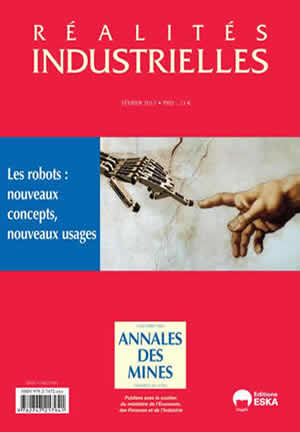|
 Février 2012 - Les robots : nouveaux concepts, nouveaux usages Février 2012 - Les robots : nouveaux concepts, nouveaux usages
Des robots humanoïdes multi-applications : le nao et ses successeurs
 Télécharger gratuitement l'article Télécharger gratuitement l'article
par Bruno MAISONNIER
Aldebaran Robotics
Si les robots industriels ont fait leur apparition dans les années 1950 aux Etats-Unis (avec pour finalité l’optimisation de la production), la robotique au service de l’homme apparaît au Japon, dans les années 1980, en réponse au vieillissement de la population de ce pays.
L’accident de la centrale nucléaire de Fukushima a réaffirmé le besoin de disposer de machines ayant les capacités de mobilité et d’agilité de l’homme, sans en présenter la fragilité. Le robot au service de l’homme exige de relever plusieurs défis : maîtriser l’interaction entre le robot et l’homme, développer l’agilité du robot, sa capacité à percevoir et à analyser son environnement, et surtout garantir la sécurité des humains évoluant à proximité.
Un ensemble de défis qui ne pourront être relevés qu’avec le développement de partenariats entre le monde de l’industrie et celui de la recherche, avec pour objectif de passer du stade de la fabrication de prototypes robotiques à celui d’une véritable industrie de la robotique de service.
 Retour au sommaire Retour au sommaire
 February 2012 - Robots : new concepts, new uses February 2012 - Robots : new concepts, new uses
Multi-tasking humanoid robots: Nao and its successors
Bruno MAISONNIER
Aldebaran Robotics
Industrial robots saw the light of day during the 1950s in the United States for the purpose of optimizing production. Robots for serving people came into being in the 1980s in Japan as a response to the ageing of the country’s population. The accident at the Fukushima nuclear power plant has emphasized the importance of having machines as mobile and agile as people but not as fragile. Placing robots in the service of human beings entails addressing several issues: how to control interactions between robots and people, how to develop the robot’s agility and its ability to perceive and analyze the environment, and, above all, how to make it safe for humans in the vicinity of robots. All this calls for partnerships between industry and academia with the objective of advancing toward the phase of developing prototypes and a service robotics industry.
 Retour au sommaire Retour au sommaire
 Februar 2012 - DIE ROBOTER : NEUE KONZEPTE, NEUE VERWENDUNGEN Februar 2012 - DIE ROBOTER : NEUE KONZEPTE, NEUE VERWENDUNGEN
Humanoide Mehrzweckroboter : Nao und die Nachfolger
Bruno MAISONNIER
Aldebaran Robotics
Industrieroboter wurden erstmals in den 1950er Jahren in den Vereinigten Staaten geschaffen (mit der Absicht, die Produktion zu optimieren), während die Assistenzrobotik für den Dienst am Menschen in Japan in den 1980er Jahren als Antwort auf die Alterung der Bevölkerung dieses Landes konzipiert wurde.
Der Unfall des Atomkraftwerks von Fukushima hat den Bedarf an Maschinen bewusst gemacht, die über die Mobilität und Gelenkigkeit des Menschen verfügen, ohne durch dessen Empfindlichkeit eingeschränkt zu sein.
An den Roboter im Dienst am Menschen werden mehrere Ansprüche gestellt : die gelingende Interaktion zwischen Roboter und Mensch, die Gelenkigkeit, die Fähigkeit, das Umfeld zu erfassen und zu analysieren und die Sicherheitsgarantie für die Menschen, die mit ihm agieren.
Es handelt sich um einen Komplex von Herausforderungen, die nur durch die Entwicklung von Partnerschaften zwischen Industrie und Forschung angenommen werden können. Ziel ist es schließlich, in der Lage zu sein, vom Stadium der Herstellung von Prototypen zu einer wahren industriellen Produktion von Servicerobotern zu gelangen.
 Retour au sommaire Retour au sommaire
 Febrero 2012 - Los robots: nuevos conceptos, nuevos usos Febrero 2012 - Los robots: nuevos conceptos, nuevos usos
Robots humanoides multi-aplicaciones, el Nao y sus sucesores
Bruno MAISONNIER
Aldebaran Robotics
Si los robots industriales se introdujeron en los Estados Unidos en 1950 (con el objetivo de optimizar la producción), la robótica al servicio del hombre aparece en Japón en la década de 1980, en respuesta al envejecimiento de la gente de ese país.
El accidente de la central nuclear de Fukushima reiteró la necesidad de contar con máquinas con las capacidades de movilidad y agilidad del hombre, pero sin sus puntos débiles.
El robot al servicio de la humanidad debe enfrentar varios retos: logar la interacción entre el robot y el hombre, desarrollar la agilidad de agilidad del robot, su capacidad para percibir y analizar su entorno y, sobre todo, garantizar la seguridad de las personas a su alrededor.
Una serie de desafíos que sólo pueden ser satisfechos con el desarrollo de asociaciones entre el mundo de la industria y de la investigación, con el objetivo de pasar de la fabricación de prototipos robóticos al de una verdadera industria de la robótica de servicios.
 Retour au sommaire Retour au sommaire
|




